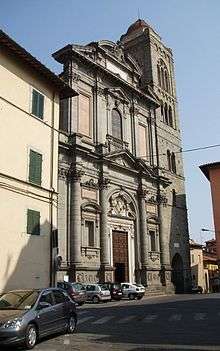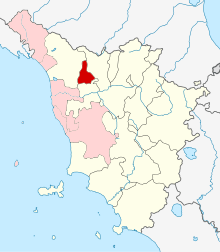Roman Catholic Diocese of Pescia
The Roman Catholic Diocese of Pescia (Latin: Dioecesis Pisciensis) is in Tuscany, about 41 miles (66 km) west of Florence. It is a suffragan of the Archdiocese of Pisa.[1][2]
Diocese of Pescia Dioecesis Pisciensis | |
|---|---|
 Pescia Cathedral | |
| Location | |
| Country | Italy |
| Ecclesiastical province | Pisa |
| Statistics | |
| Area | 224 km2 (86 sq mi) |
| Population - Total - Catholics | (as of 2016) 122,200 (est.) 112,600 (guess) |
| Parishes | 41 |
| Information | |
| Denomination | Catholic Church |
| Rite | Roman Rite |
| Established | 15 April 1519 (501 years ago) |
| Cathedral | Cattedrale di Maria SS. Assunta e S. Giovanni Battista |
| Secular priests | 47 (diocesan) 23 (Religious Orders) 6 Permanent Deacons |
| Current leadership | |
| Pope | Francis |
| Bishop | Roberto Filippini |
| Map | |
 | |
| Website | |
| www.diocesidipescia.it | |
History
Provostship
As a favor to his Datary, Baldassare Turini, who was a cleric and notary of the diocese of Lucca, and Lorenzo de Cecchis, who was a Doctor in utroque iure and parish priest of the church of S. Maria Maggiore in Pescia, Pope Leo X, in the bull "Sacri Apostolatus" of 15 April 1519, withdrew Pescia from the archdiocese of Lucca, raising it to the dignity of a prelacy nullius, and made it directly dependent upon the Holy See (Papacy). The territory was to become a Provostship, and De Cecchis was named the first Provost. A corporation of Canons. or Chapter, was established, with several dignities: the Provost, the Archdeacon, the Archpriest, the Dean, and the Primicerius. The territory of the new prelacy was to include all the churches in the Val di Nievole and the Valle Ariana. The Provost was assigned both ecclesiastical and civil jurisdiction (both of civil cases and criminal cases) in the Provostship.[3]
On 23 September 1519, Leo X issued a second bull, "Inter Caetera", in which he authorized the Bishop of Pistoia, the Bishop of Forlì, and the Abbot of Vallombrosa, to perform the canonical investiture of the new Provost, Lorenzo de Cecchis. He also fixed the number of Canons of the collegiate church at twelve, and specified that the dignities were to be the Provost, the Archdeacon, the Rector of the church of S. Stefano in Pescia (who would have the title Prior), the Rector of Ss. Matteo e Colombano in Pietrobono (with the title of Archpriest), the Dean, the Treasurer, and the Primicerius.[4]
Pope Leo X also granted to the provosts the right to use the vestments proper to a bishop, including mitre, staff, and cross, within the confines of their provostship. This was confirmed by Pope Urban VIII in the bull "Dilecti filii" of 25 February 1635, to which the pope added the right to wear the cappa magna and the mozzetta, also within the confines of his jurisdiction.[5]
A synod was held in the Provostship on 25–27 April 1694 by the Provost, Msgr. Benedetto Falconcini (1694-1704). The acts of the synod were published.[6]
Diocese
In a bull of 17 March 1726, Pescia was established as a diocese by Pope Benedict XIII, and made suffragan of (subordinate to) Pisa. The first bishop was, as was customary, the last Provost of the Collegiate Chapter, Paolo Antonio Pesenti, who had been in office since 1707. He was named Bishop-elect on 17 March 1727, but he died on 1 August 1728, before he was consecrated a bishop.[7]
Santa Maria Maggiore, dedicated to the taking up of the body of the Virgin Mary into heaven (Assumption), is referred to in documents as early as 991.[8] The original church of the parish of Pescia, S. Maria Maggiore, which had been elevated to the status of a collegiate church, needed to be replaced. An enlarged church on the same site as the old church, and incorporating some of its elements, was constructed at the end of the 17th century, to designs by the Florentine architect, Antonio Ferri. The campanile is of the 14th century, though its uppermost part is of the late 18th century.[9]
In 1742, the cathedral Chapter was composed of seven dignities and twelve Canons. The city of Pescia had about 5,000 inhabitants.[10]
In 1784, with the cooperation of Grand Duke Leopold I, the diocesan seminary was opened.[11]
By 1833, the population of the entire diocese of Pescia had risen to a total of 49,890 persons.[12]
Bishops of Pescia
- Bartolomeo Pucci Franceschi (1728–1737)[13]
- Francesco Gaetano Incontri (1738–1741)[14]
- Donato Maria Arcangeli (1742–1772)[15]
- Francesco Vincenti (1773–1803)[16]
- Giulio Rossi (1804–1833)[17]
- Giovanni Battista Rossi (1834–1837)[18]
- Vincenzo Menchi (1839–1843)[19]
- Pietro Niccolò Forti (1847–1854)
- Giovanni Antonio Benini (Bedini) (1855–1896)
- Giulio Matteoli (1896–1898)[20]
- Donato Velluti Zati di San Clemente (1898–1907 Resigned)
- Giulio Serafini (1907)[21]
- Angelo Simonetti (1907–1950)
- Dino Luigi Romoli, O.P. (1951–1977 Retired)
- Giovanni Bianchi (1977–1993 Retired)
- Giovanni De Vivo (1993–2015 Died)
- Roberto Filippini (2015– )
Current Bishop
On 25 November 2015, Pope Francis appointed as the new Bishop of the Diocese of Pescia, in Pescia, Italy, Roberto Filippini, S.T.L., a priest of the Roman Catholic Archdiocese of Pisa. Bishop Filippini was born in Vinci, Florence, Italy, on 6 June 1948. He studied for his undergraduate philosophy degree in the Archdiocesan Seminary of Pisa. He completed his graduate theological studies at the Almo Collegio Capranica, and attended the Pontifical Gregorian University as well as the Pontifical Biblical Institute, obtaining the Licentiate in Sacred Theology and in Sacred Scripture. He was ordained a priest on 14 April 1973, age 24, for the archdiocese of Pisa. He was Parochial Vicar (Associate Pastor) in the Parish of St. Hermes in Forte dei Marmi, Italy, from 1975 to 1978, and undertook teaching at the Seminary of Pisa. He was a Parish Priest in Calignola, Italy, from 1978 to 1984; from 1984 to 1997, Pastor of the Parish of Santo Sepolcro (Pisa) in Pisa; and from 1997, Parish Priest of San Martino, Italy. In 1996, he was appointed President of the Studio Teologico Interdiocesano di Camaiore (seminary) in Lucca, Italy. From 1999 to September 2015, Filippini was Rector of the Seminary "Santa Caterina" in Pisa. From 1999 to 2015, he served as a Prison Chaplain at a prison in Pisa. He has also been a Professor of Fundamental Theology and Sacred Scripture at the Higher Institute of Religious Sciences of Blessed Nicholas Steno, in Pisa, and at the School of Theological Education.[22]
Notes and references
- "Diocese of Pescia" Catholic-Hierarchy.org. David M. Cheney. Retrieved 29 February 2016.
- "Diocese of Pescia" GCatholic.org. Gabriel Chow. Retrieved 29 February 2016.
- Cappelletti XVIII, pp. 323-340, quotes the bulls in their entirety.
- Cappelletti, p. 332.
- Cappelletti, pp. 355-356.
- Benedetto Falconcini (1694). Decreta et constitutiones synodales eccl.ae praepositurae Piscien. habitae a reverendissimo domino d. Benedicto Falconcini ... die 25. 26. & 27. Aprilis 1694 (in Latin). Florence: apud Petrum Matini praepositurae Piscien. typograph.
- Cappelletti XVIII, p. 358. Ritzler-Sefrin, Hierarchia catholica V, p. 315, note 1. A. Labardi, La comunità ecclesiastica pesciatina nel corso dei secoli. Percorsi storici di una Chiesa locale, in: A. Spicciani (ed.), Pescia. La storia, l'arte e il costume, Pisa 2001, p. 87.
- Cappelletti, p. 561. Repetti, p. 131, credits its beginnings to the 8th century.
- Cappelletti, p. 358, quoting an inscription concerning the construction of the bell tower, dated 1306.
- Ritzler-Sefrin, Hierarchia catholica VI, p. 339, note 1.
- Repetti, p. 132 column 2.
- Repetti, p. 134.
- Pucci was a native of Montepulciano. Cappelletti, p. 370. Ritzler-Sefrin, Hierarchia catholica V, p. 315, note 2.
- A native of Volterra, Incontri was transferred to the diocese of Florence by Pope Clement XII on 5 May 1738. Ritzler-Sefrin, Hierarchia catholica VI, p. 339, with note 2.
- Arcangeli was a native of Arezzo. Ritzler-Sefrin, Hierarchia catholica VI, p. 340, with note 3.
- Vincenti was a native of Livorno. Ritzler-Sefrin, Hierarchia catholica VI, p. 340, with note 4.
- Rossi: Ritzler-Sefrin, Hierarchia catholica VII, p. 308.
- Rossi was transferred to the diocese of Pistoia e Prato by Pope Gregory XVI on 2 October 1837. Ritzler-Sefrin, Hierarchia catholica VII, p. 308.
- Menchi was appointed Bishop of Fiesole by Pope Gregory XVI on 30 January 1843. Ritzler-Sefrin, Hierarchia catholica VII, pp. 194, 308.
- Matteoli had been Bishop of Sovana e Pitigliano (1889–1896). He was transferred to Pescia on 22 June 1896 by Pope Leo XIII. On 24 March 1898, Matteoli was transferred to the diocese of Bishop of Livorno by Leo XIII. He died on 25 July 1900. Ritzler-Sefrin, Hierarchia catholica VIII, pp. 342, 456, 523.
- Serafini was born in Bolsena (Orvieto). He studied at the Roman Pio Seminary in Rome, and held the degree of Doctor in utroque iure. He taught at the seminary of Orvieto for five years, becoming its Rector. He was then Rector of the Roman Pio Seminary (1901–1913), and a papal chamberlain, while teaching at the seminary of S. Apollinaire. He was appointed Bishop of Pescia on 15 April 1907. He was named Titular Bishop of Lampsacus by Pope Pius X on 16 December 1907. On 30 June 1930, Pope Pius XI named him a cardinal. Pięta, Hierarchia catholica IX, pp. 217, 302. Martin Bräuer (2014). Handbuch der Kardinäle: 1846-2012 (in German). Berlin: De Gruyter. p. 277. ISBN 978-3-11-026947-5. Harris M. Lentz III (2002). Popes and Cardinals of the 20th Century: A Biographical Dictionary. McFarland. p. 172. ISBN 978-1-4766-2155-5.
- Vatican Press Release, 25 November 2015.
Books
- Gams, Pius Bonifatius (1873). Series episcoporum Ecclesiae catholicae: quotquot innotuerunt a beato Petro apostolo. Ratisbon: Typis et Sumptibus Georgii Josephi Manz. p. 762. (Use with caution; obsolete)
- Ritzler, Remigius; Sefrin, Pirminus (1952). Hierarchia catholica medii et recentis aevi (in Latin). Tomus V (1667-1730). Patavii: Messagero di S. Antonio.
- Ritzler, Remigius; Sefrin, Pirminus (1958). Hierarchia catholica medii et recentis aevi. Tomus VI (1730-1799). Patavii: Messagero di S. Antonio.
- Ritzler, Remigius; Sefrin, Pirminus (1968). Hierarchia Catholica medii et recentioris aevi (in Latin). Volume VII (1800–1846). Monasterii: Libreria Regensburgiana.
- Remigius Ritzler; Pirminus Sefrin (1978). Hierarchia catholica Medii et recentioris aevi (in Latin). Volume VIII (1846–1903). Il Messaggero di S. Antonio.
- Pięta, Zenon (2002). Hierarchia catholica medii et recentioris aevi (in Latin). Volume IX (1903–1922). Padua: Messagero di San Antonio. ISBN 978-88-250-1000-8.
Studies
- Ansaldi, Giuseppe (1872). Cenni biografici dei personaggi illustri della città di Pescia e suoi dintorni (in Italian). Pescia: Tip. Vannini. p. 1.
- Banti, Ottavio (2003). Pescia: la città e il Vescovato : nella bolla del papa Benedetto XIII del 17 marzo 1727 (in Italian). Pisa: ETS. ISBN 978-88-467-0662-1.
- Cappelletti, Giuseppe (1864). Le chiese d'Italia (in Italian). decimotto (18). Venezia: G. Antonelli. pp. 321–364.
- Nucci, Ermenegildo (1937). I vescovi di Pescia dall'anno 1726 al 1908 (in Italian). Pescia: Stamperia G. Franchi.
- Repetti, Emanuele (1841). Dizionario geografico fisico storico della Toscana contenente la descrizione di tutti i luoghi del Granducato, Ducato di Lucca Garfagnana e Lunigiana (in Italian). Vol. IV (P-R). Firenze: Allegrini e Mazzoni. pp. 113–134.
- Storia della Val di Nievole dall'origine di Pescia fino all'anno 1818 (in Italian). Pistoia: Cino. 1846.